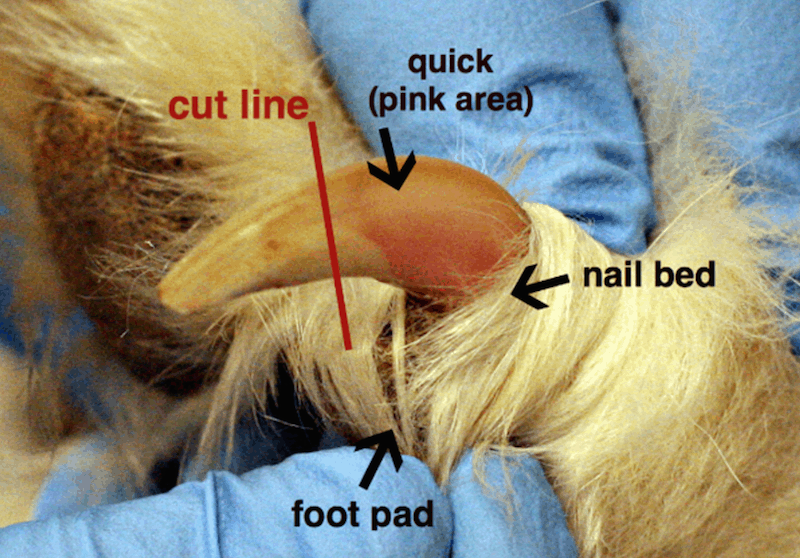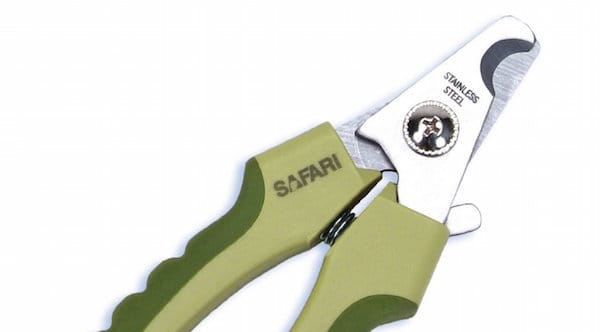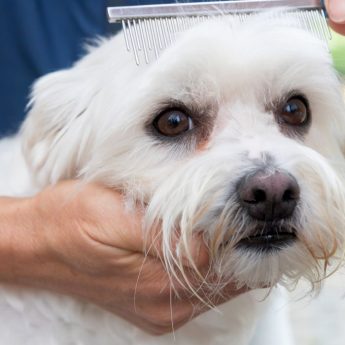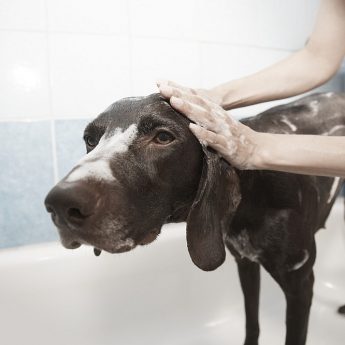
Just like us humans need to cut our own finger nails regularly, dogs needs to have their nails trimmed from time to time as well.
How often should you cut your dog’s nails? On average, most dogs will need to have their nails trimmed every 1-2 months. You can also tell that your dog’s nails need to be trimmed if they are clicking on the floor when your dog walks.
Dogs’ front nails tend to grow faster than back nails, so you may not need to trim your dog’s rear nails as frequently as the front nails.
However, as with so many things, how often you need to cut your dog’s nails usually depends on a variety of factors, such as:
- Activity. Dogs that walk regularly on pavement will naturally have their nails worn down, so they won’t need their nails trimmed as often.
- Age. Dogs who are older tend to be walking less often, which might mean they’ll need more frequent clippings than dogs who have their nails naturally worn during walks.
- Environment. Even if your dog is very active and goes on lots of walks, if he or she is walking on dirt or grass, your dog’s nails won’t be worn down the way they would be if your dog was walking on asphalt, sidewalks, or other rough surfaces.
- Breed. Some dog breeds have nails which will grow more quickly than other breeds, so they may require more frequent nail trimmings. Small dogs like Chihuahuas that spend the majority of their time indoors will definitely need to have their nails cut short.
- Nail Length. If your dog’s nails have managed to get quite long, you’ll want to cut the nails every 2-3 weeks to help wear down the quicks (cutting close to the quick encourages the quick to shrink back). Extra long nails have to be cut a little bit at a time and should not be cut short all at once.
When You Don’t Cut Nails: When you don’t cut your dog’s nails, your dog may become very uncomfortable, with long nails sometimes causing joint and bone issues.
Longer nails can also result in snagging and breakage, which is very painful for your pooch and in some cases may even require a trip to the vet for sedation and repair or removal. Some dog’s nails will curl under their feet and grow into the dog’s foot pads, which hurts and can become infected.

If you’ve ever let your own nails grow too long, you know how awkward it can feel. Don’t let your dog’s nails go Wolverine style!
Common Problems With Cutting A Dog’s Nails
- Dog Anxiety. Many owners have issues keeping their dog calm during the nail cutting process, and it’s not unusual for dogs to be terrified of getting their nails cut (usually due to a past bad experience). My previous dog never growled at me – except when I would try to cut his nails. He really hated it!
- Bleeding. Dogs have a blood vessel that runs through their nails, which is called the quick. If you cut too much of your dog’s nails, you might accidentally cut into the quick, which will cause the nail to bleed. This is not fun for your dog and can be frightening for owners as well. If you cut into the quick, don’t panic! Wipe away the blood, grab some styptic powder, and pat the powder around the nail area and bleeding should stop.
While cutting the quick does hurt your pooch, the pain shouldn’t last long and they shouldn’t have a problem walking afterwards. Give your pup a break and a reward him before moving to the other nails. If your dog has very long nails, be extra careful, since the quicks are likely long as well. One method is to cut a small tip off the nails every couple of weeks to encourage the quicks to shrink back.
- Dark Colored Nails. While the quick is easy to see (and avoid) on light-colored nails, it can be much more difficult to see on dark colored nails. Ideally, you’ll want to cut 2-3 millimeters from the nail quick. When cutting dark nails, since it’s so difficult to see the quick, it’s better to be safe than sorry. While the narrow tip of the nail should be fine to cut, you’ll want to be very careful when you begin to cut the wider section of nail. Only cut 2mm at a time, and after each cut, look at the nail. When you begin to see the center of the nail turn a white or grey flesh-like color, stop cutting.

- Squirmy Dogs. Some dogs really dread getting their nails cut and will squirm the whole time. You may want to try to get help to keep your dog still. However, if your dog really won’t stop squirming, it might be best to leave the task to the pros. You certainly don’t want to cut the nails of a moving dog, since this will increase chances of injury and cutting the painful quick area.
- Bad Experience Leading to More Fear. Unfortunately, if you mess up and cut into your dog’s quick a few times, he or she will be much less receptive to future nail cutting sessions, making the situation even more difficult.
How to Have a Good Nail Cutting Experience
Visit a Vet or Groomer. When you take a trip to the vet, have your vet show you how to cut your dog’s nails (they’re pros so they should be able to show you the best method for your particular pooch). If things really get hairy between you and your canine during nail cutting sessions, you may want to opt for taking your dog to the groomer to get his nails cut. Groomers know all the tricks of the trade to keep your dog calm and are used to anxious canines.
Handle Your Dog’s Paws Early. One of the best ways to ensure future nail cutting goes smoothly is to get your dog accustomed to having his paws held. Gently rub your dog’s feet and reward him for good behavior with praise and treats.
Get Some Help. Many owners find that it’s easier to cut their canine pal’s nails when someone else is there to keep the dog calm and even hold him still if he is squirming. Ideally, you’ll probably want your dog to be lying down when you cut his nails (this tends to be the easiest position to work with).
Don’t Wait to Start Cutting Your Puppy’s Nails. As noted above, you’ll want to start handling your puppy’s paws right when you get him or her. Play with his toes while giving him treats so he crates a positive association. Once his nails have grown a bit, begin cutting them, but only cut a tiny bit of nail (you really want to avoid cutting anywhere near the quick, since creating a positive experience is the real goal). Trim a little bit of nail every week or so to teach your puppy that getting his nails cut is no big deal. Then in the future, nail cutting will become much easier!
Get The Gear: What You Need For Dog Nail Cutting
Dog nail trimmers are essential dog grooming tools – but you actually have a couple different options for trimming, allowing you to choose between nail clippers or grinders (or both).
- Stainless Steel Nail Trimmer. Look for a stainless steel nail trimmer that can make a sharp, clean cut. You may also want to look for a nail trimmer the includes a safety guard to stop dog owners from accidentally clipping too much nail. We recommend going with the Safari Nail Trimmer – it’s one of the most popular dog nail trimmers online.

- Dog Nail Cutting Rotary Grinder. If clipping isn’t working out for you, consider trying a nail cutting grinder. Instead of cutting your dog’s nails, these tools grind down your dog’s nails with a rotary tool (think of it as high-powered sandpaper).
If you want to give rotary grinders a try, we suggest checking out the Dremel Pet Grooming Grinder, which comes very highly rated on Amazon and is specifically designed for trimming pets’ nails. Note that while rotary tools are painless, the sound and vibrations can freak dogs out, so it may take some time to get them accustomed to it.

- Styptic Powder. We also recommend having some styptic powder in case you do accidentally cut into your dog’s nail quick and the nail starts bleeding. Styptic powder can quickly stop the bleeding and keeps everyone feeling a bit calmer! Try grabbing some Miracle Care Kwik Stop Styptic Powder, which is specifically made for pets.







10 Comments
November 13, 2018
Hi even though i already knew some of this info add tips but the rest of your nail trimming article was very helpful. Thank you so much.
November 14, 2018
You’re very welcome Tanya!
July 4, 2018
I have a 7 yr old German Shepherd cross, about the same size as a Husky. I have been grinding his nails since we got him 5 yrs ago. I started off with a PediPaws and got the green one with a light when that quit. I grind by giving a nail a stroke from underneath around the front of the nail, I do not keep it in one place and push. A problem with any grinder is that grinding produces heat – I found out the hard way when grinding an errant toe nail of my own. So I limit the number of strokes in a phrase to six – four to remove bulk, and then a stroke each side to remove the sharp edges. The front nails get two sessions, the back nails get one session, and the dew claws get three light strokes. I do him once a week, and he gets a good combing afterwards.
July 5, 2018
Sounds like you have a good system down!
February 3, 2020
The up side the friction heat is that as you get close to the quick the grinder actually can help by cauterizing the quick(blood vessel) !
May 27, 2018
My dog has long nails and we cut them every week to two. They always bleed. The quick doesn’t seem to be moving back. She only gets a small amount clipped off. What can we do?
May 27, 2018
Hmm, that’s tough Lisa. You might want to try a nail grinder instead. Usually when you cut off just a bit of the nail, the quick will retract, so hard to say what is going on with your pooch.
May 24, 2018
Your article was very helpful. Many thanks
May 24, 2018
You’re welcome Sam! We’re happy to help.
June 2, 2017
I just got a husky, and I want to make sure that he is getting the right grooming care he needs. That’s so interesting how dogs that walk on dirt or grass may have longer nails compared to those that have worn nails from sidewalks and pavement. As you suggested, we’ll be sure to have our vet to help us know how to cut his nails.